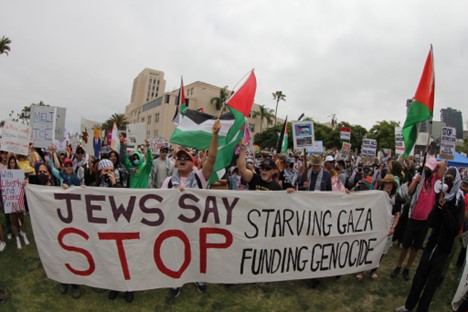Gaza Is the “Hungriest Place on Earth”
PALESTINE ISRAEL GAZA GENOCIDE, 28 Jul 2025
The Wire | Jewish Voice for Peace – TRANSCEND Media Service
23 Jul 2025 – Palestinians in Gaza are being starved to death and risking their lives to collect what meager rations Israel allows into Gaza.
Dozens of Palestinians, the vast majority of them children, have died of starvation since the beginning of the genocide. But now, Israel’s campaign of mass starvation has reached a tipping point: Over 50 children died of malnutrition in the four and a half months since Israel imposed a total blockade on Gaza.
Desperate to feed their families, Palestinians are trekking for hours under the hot sun — and being gunned down or crushed under stampedes — in the hopes of collecting bags of flour and other basic necessities at Israeli and U.S.- run aid sites.
“The hungriest place on earth.”
Even before October 2023, killings by the Israeli military and settlers in the West Bank were on the rise. Dozens of Palestinian children have starved to death in the months since the Israeli government imposed a total blockade on Gaza.
At least 57 children had died of malnutrition by mid-May. By the end of May, the U.N. Office for the Coordination of Humanitarian Affairs (OCHA) was calling Gaza “the hungriest place on earth”: the only defined territory in the world where the entire population is at risk of famine.
Today, 1 in 10 Palestinian children in Gaza are suffering from acute malnutrition. Across Gaza, nearly 1 in 3 Palestinians are going days without food. In Gaza’s last functioning hospitals, doctors and nurses are passing out as a result of hunger and exhaustion.
Last weekend, 19 Palestinians died of starvation in a single day. In the 24 hours before this Wire was published, another 15 Palestinians died of starvation, among them four children.
This crisis, manufactured by the Israeli government, is only compounded by its intentional destruction of critical infrastructure and months-long blockade on fuel. Desalination plants and other water treatment facilities have been forced to shut down, prompting what UNICEF referred to as a “man-made drought.” Today, 95% percent of Gaza faces water insecurity. As fuel dwindles, even the trucks tasked with delivering containers of water are being replaced by donkey carts: “the last gasp of a collapsing system.”
Less than half of Gaza’s hospitals are still functioning, with dozens of medical facilities forced out of operation because of fuel shortages and relentless Israeli attacks. With critical infrastructure devastated and wastewater treatment plants shuttered, sewage flows into the streets and into makeshift tents. Untold numbers of Palestinians are dying from lack of care: from premature babies taken off of oxygen as hospitals run out of fuel, to dialysis patients forced to journey through the rubble in the hopes of finding an operating clinic, to pregnant women giving birth without care and emaciated children dying from treatable diseases.
Though Israel is allowing a trickle of aid into Gaza, the few dozen trucks entering Gaza daily will not — and were never intended to — stave off mass starvation. UNRWA, formerly the largest distributor of humanitarian aid in Gaza, has been blocked from operating in the territory since March. Instead, the U.S. and Israel governments tasked the newly-formed “Gaza Humanitarian Foundation” (GHF), founded in February 2025, with distributing whatever meager rations Israel allows into Gaza at just four aid sites: a tiny operation compared with the hundreds of facilities formerly run by the U.N.
“Dreaming of getting a bag of flour.”
Israeli forces have opened fire on crowds of starving Palestinians again and again at GHF aid sites, which are engineered to be death traps: giving Palestinians only minutes to collect food before Israeli soldiers open fire on the crowd. Over 1,000 Palestinians have been killed by Israeli forces at these sites or near other relief convoys since the end of May.
On July 16, guards from the GHF launched stun grenades and used pepper spray to disperse dozens of desperate people who had made their way into a closed, fenced-in aid site in Khan Younis. A deadly stampede ensued: men, women, and children suffocated from the gas and were crushed underfoot, killing at least 21 people. A few days later, Israeli forces opened fire on a crowd of Palestinians trying to collect aid near the Zikim crossing in north Gaza, where a convoy of aid trucks was passing. At least 86 people were killed. “Either you get the flour or you get shot,” one survivor told Mada Masr.
All but one of four GHF sites are located in Gaza’s far south: a deliberate ploy intended to force hundreds of thousands of starving Palestinians to leave their homes, potentially never to return.
“This is aid being used … to push people out from the north into militarised zones … and it’s about humiliating people, and it’s about controlling the population. This has nothing to do with stopping starvation,”
-UN special rapporteur on the right to food Michael Fakhr
The journey is treacherous: Many Palestinians — starving, sick, and injured — walk for hours under the hot sun. Those lucky enough to have vehicles or carts can only take them to a certain point; they are then forced to disembark and make the remainder of the journey (about 1 mile) on foot, towards a GHF distribution site near Rafah.
Terrified to remain out in the open for too long, Palestinians hurry past an Israeli barricade to take shelter from Israeli snipers. They wait, sometimes for up to 24 hours, for a “go signal” from Israeli military drones that buzz overhead. Even after waiting for the signal, there are Palestinians who are shot dead while walking the remaining half mile to the site. And even for those who survived the journey, there is no guarantee of collecting aid. Instead, Palestinians are greeted by chaos:
“Every time I go to get aid, I hold a box and hundreds of people crowd over me. If you are strong, you get aid. If you are not, you leave empty-handed”
-Abdel Qader Rabie, a Palestinian displaced in Gaza
Israeli soldiers are being ordered to open fire on unarmed civilians. In a voice note shared with The Intercept, Maher Ahmed described narrowly escaping a GHF aid site with his life. Having gone three days without flour, he set off with three friends for Dewar Al’aalam. Though they were signalled by American contractors to enter the site, soon gunfire rang out. Maher’s friend, Mohammed, died instantly after being shot in the head, chest, and stomach. “I survived by a miracle, by a big miracle,” Maher said. “And I lost my friend, Mohammed. Mohammed was only dreaming of getting a bag of flour for his mother and family.”
“Precisely designed mass starvation.”
It has been clear from the beginning that the GHF is entirely ill-equipped to act as the sole distributor of aid in Gaza. The Israeli and U.S. decision to turn over aid distribution to the GHF was widely condemned by human rights groups around the world, and the UN and hundreds of charities have called to shut down its operations in Gaza.
In May, a day before the GHF opened its first site in Gaza, its executive director resigned, concluding that “it is not possible to implement this plan while also strictly adhering to the humanitarian principles of humanity, neutrality, impartiality, and independence.”
Days before the Trump administration approved a $30 million grant for the GHF earlier this month, USAID raised “critical concerns” about the group’s operations in Gaza, saying its overall plan lacked “even basic details.”
Even for those desperate enough to brave Israeli gunfire and deadly stampedes, the GHF has, by design, made aid collection next to impossible. According to a forthcoming report by Forensic Architecture, the Gaza Humanitarian Foundation announces that a site will be open, on average, only 17 minutes ahead of time. Since mid-June, GHF sites have been open for about 10 minutes at a time. That means Palestinians — many of whom would have to walk hours just to reach an aid site — are forced to permanently relocate nearby.
“I’ve been working on this field of famine, food crisis and humanitarian action for more than 40 years, and there is no case, over those four decades, of such minutely engineered, closely monitored, precisely designed mass starvation of a population as is happening in Gaza today.”
-Alex De Waal, executive director of World Peace Foundation at Tufts University
__________________________________
 Jewish Voice for Peace, with roughly 750,000 members, supporters, and participants, is the largest progressive Jewish anti-Zionist organization in the world; a national, grassroots, multiracial, cross-class, intergenerational movement of U.S. Jews working towards Palestinian freedom and Judaism beyond Zionism. We envision a world where all people live in freedom, justice, equality, and dignity and believe that through organizing, we can and will dismantle the institutions and structures that sustain injustice.
Jewish Voice for Peace, with roughly 750,000 members, supporters, and participants, is the largest progressive Jewish anti-Zionist organization in the world; a national, grassroots, multiracial, cross-class, intergenerational movement of U.S. Jews working towards Palestinian freedom and Judaism beyond Zionism. We envision a world where all people live in freedom, justice, equality, and dignity and believe that through organizing, we can and will dismantle the institutions and structures that sustain injustice.
Go to Original – jewishvoiceforpeace.org
Tags: Anti Zionism, Collective Punishment, Crimes against Humanity, Cultural violence, Direct violence, Ethnic Cleansing, Famine, Gaza, Genocide, Hamas, Hunger, International Court of Justice ICJ, Israel, Israeli occupation, Nakba, Palestine, Sociocide, State Terrorism, Structural violence, USA, War crimes, West Bank
JOIN THE BDS-BOYCOTT, DIVESTMENT, SANCTIONS CAMPAIGN TO PROTEST THE ISRAELI BARBARIC GENOCIDE OF PALESTINIANS IN GAZA.
DON'T BUY PRODUCTS WHOSE BARCODE STARTS WITH 729, WHICH INDICATES THAT IT IS PRODUCED IN ISRAEL. DO YOUR PART! MAKE A DIFFERENCE!
7 2 9: BOYCOTT FOR JUSTICE!
DISCLAIMER: The statements, views and opinions expressed in pieces republished here are solely those of the authors and do not necessarily represent those of TMS. In accordance with title 17 U.S.C. section 107, this material is distributed without profit to those who have expressed a prior interest in receiving the included information for research and educational purposes. TMS has no affiliation whatsoever with the originator of this article nor is TMS endorsed or sponsored by the originator. “GO TO ORIGINAL” links are provided as a convenience to our readers and allow for verification of authenticity. However, as originating pages are often updated by their originating host sites, the versions posted may not match the versions our readers view when clicking the “GO TO ORIGINAL” links. This site contains copyrighted material the use of which has not always been specifically authorized by the copyright owner. We are making such material available in our efforts to advance understanding of environmental, political, human rights, economic, democracy, scientific, and social justice issues, etc. We believe this constitutes a ‘fair use’ of any such copyrighted material as provided for in section 107 of the US Copyright Law. In accordance with Title 17 U.S.C. Section 107, the material on this site is distributed without profit to those who have expressed a prior interest in receiving the included information for research and educational purposes. For more information go to: http://www.law.cornell.edu/uscode/17/107.shtml. If you wish to use copyrighted material from this site for purposes of your own that go beyond ‘fair use’, you must obtain permission from the copyright owner.
Join the discussion!
We welcome debate and dissent, but personal — ad hominem — attacks (on authors, other users or any individual), abuse and defamatory language will not be tolerated. Nor will we tolerate attempts to deliberately disrupt discussions. We aim to maintain an inviting space to focus on intelligent interactions and debates.
Read more
Click here to go to the current weekly digest or pick another article:
PALESTINE ISRAEL GAZA GENOCIDE:
